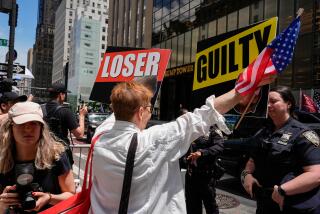Spare Us a Revival of Kerouac and the Pied Pipers of Despair
When I read the other day that the City Council of Lowell, Mass., had just decided to build a new park dedicated to the memory of Jack Kerouac, my first reaction was amazement.
Though born in Lowell, Kerouac was not just a local boy who made good. As the leading novelist of the Beat Generation, he “spit forth” (to borrow a phrase from the leading Beat poet, Allen Ginsberg) a series of books heaping abuse on the way of life lived in places like Lowell. That way of life he represented as hardly better than no life at all. It was, he said--most famously in “On the Road” and then again and again and yet again--a form of spiritual death.
To Kerouac the only people in America who could be considered really alive were those outside the system--bums, thieves, whores, junkies and anyone lucky enough to possess a dark skin. Such people he celebrated as “the mad ones, the ones who are mad to live, mad to talk, mad to be saved, desirous of everything at the same time, the ones who never yawn or say a commonplace thing, but burn, burn, burn like fabulous yellow roman candles exploding like spiders across the stars.”
It is true that in his last years, before he himself burned out in 1969 at the age of 47, Kerouac got off the road, settled down in a suburb with his wife and mother, and returned to the Roman Catholic Church. He also moved to the right in his political views. But this is not the Kerouac the world remembers.
Nor is it as a great novelist that Kerouac’s memory survives. There are critics who continue making the claim of artistic distinction on his behalf, but the simple fact is that Kerouac lacked the two essential gifts of the true novelist: He could not create believable characters, and he could not tell a compelling story.
What he could do was produce highly charged narcissistic monologues, formless and incoherent explosions of what Ginsberg called “spontaneous bop prosody.” These attracted attention in the late 1950s, but not on the basis of literary merit; they were taken as the sign that a new generation of rebellious spirits was supplanting the allegedly conformist and “silent” young people of the first postwar decade.
Within a short time, the values celebrated by Kerouac, Ginsberg and all the other Beat writers had established themselves as the orthodox dogmas of what came to be known as the “counterculture.” Dropping out, hitting the road, taking drugs, hopping from bed to bed with partners of either sex or both--all in the name of liberation from the death-dealing embrace of middle-class conventions--came to be as “in” among the middle-class young of the ‘60s as early marriage and the pursuit of career had been 10 years before.
This, then, is what the city of Lowell is inescapably honoring in building a monument to Kerouac. But if my reaction on hearing the news was amazement, on reflection I realize that I should not have been all that surprised. For one thing, in honoring Kerouac his hometown is only joining a campaign already in progress to pay retroactive homage to the writers of the Beat Generation.
Reverential histories and laudatory critical analyses have for some years now been pouring out of the universities. A huge volume of Ginsberg’s poems, most of which were originally brought out by “underground” presses, was recently issued by a major commercial publisher. And, in an even more symptomatic gesture, the same commercial publisher has also issued a special deluxe edition (complete with facsimiles of earlier drafts, long explanatory notes by the author and surrounding historical documents) of Ginsberg’s “Howl,” the long poem that, together with Kerouac’s “On the Road,” served on its original appearance in 1956 as the manifesto of the Beat Generation.
From a strictly literary point of view, Ginsberg’s poems (especially when he is in a humorous mood) are much better than Kerouac’s novels. Yet it would be foolish to assume that they have arrived at their exalted status by virtue of aesthetic excellence.
“Howl” in particular owes its greater fame much less to the ranting, unmodulated and derivative Whitmanesque rhetoric that Ginsberg tried to pass off as a revitalized style of versification than to its character as a “prophetic” document. In its glorification of madness, drugs and homosexuality, and in its contempt and hatred for anything and everything generally deemed healthy, normal or decent, Ginsberg’s poem simultaneously foreshadowed and helped to propagate the values of the youth culture of the 1960s.
“I’m worried about a role model for kids,” explained the lone member of the Lowell City Council who voted against the Kerouac memorial. He is right to worry. After all, Kerouac and Ginsberg once played a part in ruining a great many young people who were influenced by their “distaste for normal life and common decency.”
The phrase that I have just quoted comes not from the Lowell city councilman but from George Orwell, who was talking not about Ginsberg and Kerouac but about some of his own contemporaries in the England of the 1930s whose writings expressed many of the same attitudes. As against them, Orwell said, “The fact to which we have got to cling, as to a lifebelt, is that it is possible to be a normal decent person and yet to be fully alive.”
Instead, we memorialize Ginsberg and Kerouac, thereby further weakening our already tenuous grasp on Orwell’s saving fact and abandoning the field once again to these latter-day Pied Pipers and their current successors who keep telling our children that the life being lived around them is not worth living at all.
More to Read
Sign up for our Book Club newsletter
Get the latest news, events and more from the Los Angeles Times Book Club, and help us get L.A. reading and talking.
You may occasionally receive promotional content from the Los Angeles Times.









